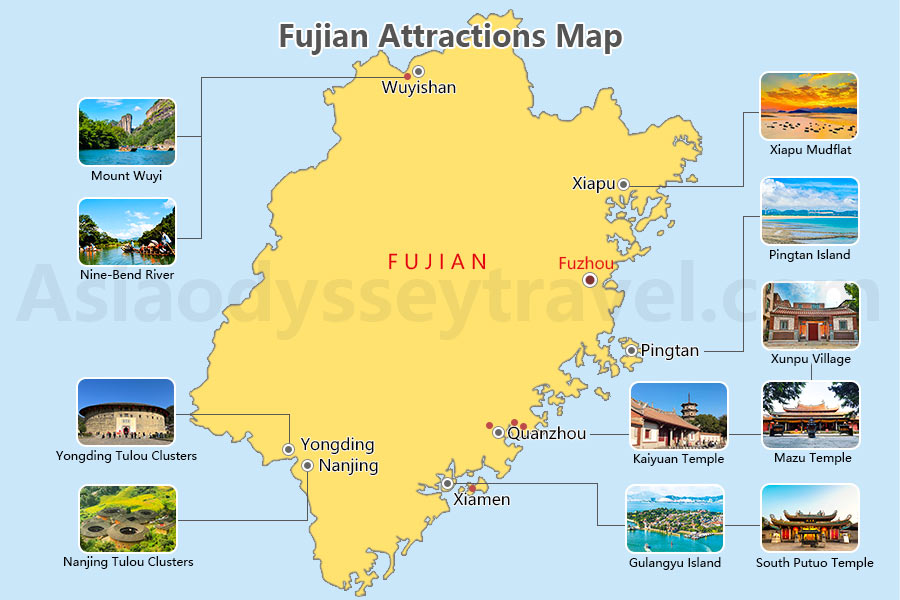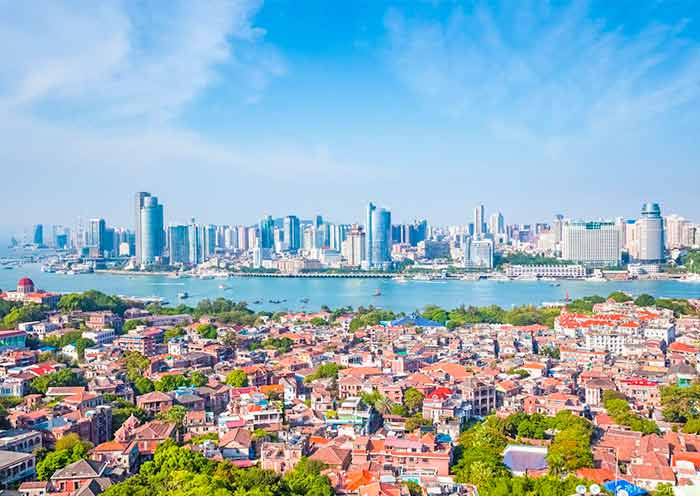Xiamen Location Map: Where is Xiamen in China
Xiamen is a coastal city located in southeastern China, in Fujian Province. Situated on the southeast coast of China, Xiamen is known for its vibrant port, beautiful beaches, and subtropical climate. The city is an important economic center and a popular tourist destination, famous for attractions such as Gulangyu Island, Nanputuo Temple, and the Hulishan Fortress. Xiamen is also recognized for its cultural heritage, delicious seafood, and as a hub for cross-strait relations with Taiwan.
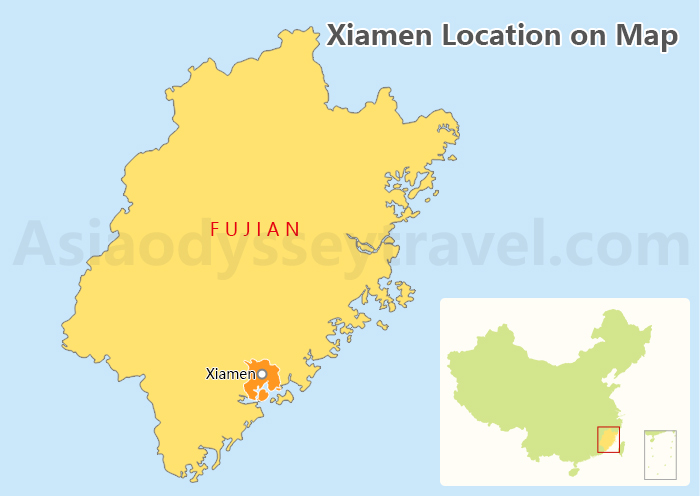
Xiamen Tourist Map: Top Attractions in Xiamen
Xiamen offers a variety of tourist attractions that blend natural beauty with cultural heritage. Here are some popular tourist attractions in Xiamen:
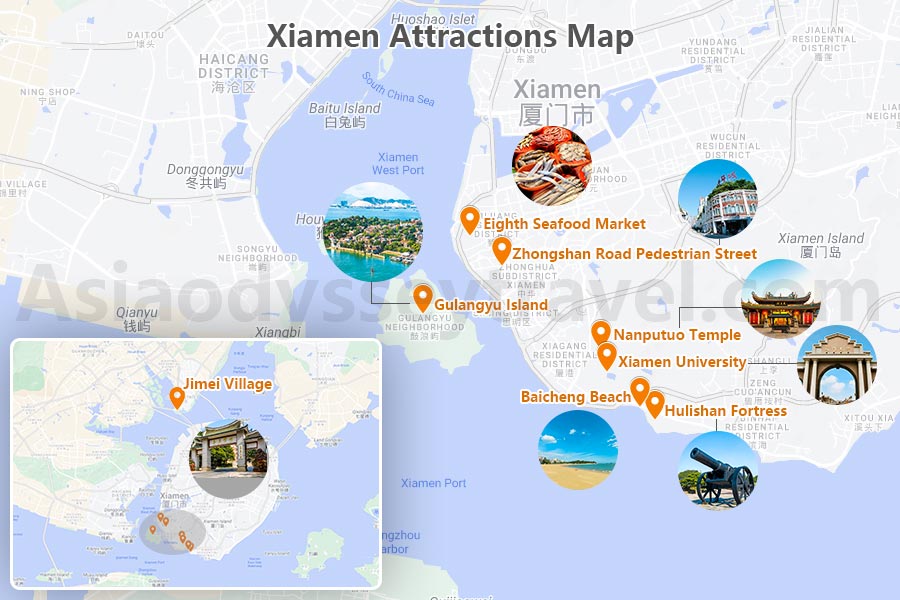
- Gulangyu Island: Known as "Piano Island" for its musical history, Gulangyu is a car-free island with colonial architecture, winding lanes, and beautiful beaches.
- Nanputuo Temple: A Buddhist temple with a history dating back over a thousand years, Nanputuo Temple is known for its peaceful atmosphere and intricate architecture.
- Xiamen University: One of China's most picturesque campuses, Xiamen University features traditional Chinese architecture and beautiful gardens, making it a popular spot for visitors.
- Hulishan Fortress: This historic fortress dates back to the late 19th century and features well-preserved walls, cannons, and panoramic views of the sea.
- Zhongshan Road Pedestrian Street: A bustling shopping street lined with shops, cafes, and restaurants, Zhongshan Road is a great place to experience local culture and sample Xiamen's famous snacks.
- Jimei Village: Founded by the renowned Chinese educator Tan Kah Kee, Jimei Village is a cultural and educational center with traditional architecture, museums, and gardens.
- Baicheng Beach: Baicheng Beach (白城沙滩) in Xiamen is a must-visit for beach enthusiasts. Its proximity to Xiamen University makes it popular among students and tourists.
- Eighth Seafood Market: The Eighth Seafood Market (第八生鲜市场) in Xiamen is a renowned tourist hotspot celebrated for its fresh seafood, diverse array of seafood dishes, and wallet-friendly prices.
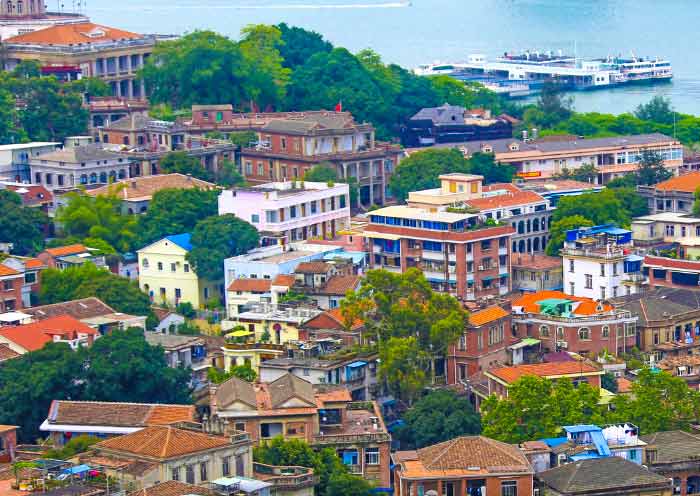

These attractions offer a mix of history, culture, and natural beauty, making Xiamen a delightful destination for visitors.
Xiamen City Map: Xiamen Airport Map & Xiamen Station Map
Xiamen Gaoqi International Airport (XMN):
- Location: Located in Huli District, Xiamen Gaoqi International Airport is approximately 10 kilometers (6 miles) from the city center of Xiamen.
- Transportation: The airport is accessible by airport shuttle buses, taxis, and the Xiamen Metro Line 1. Travelers can easily reach the city center and other parts of Xiamen using these transportation options.
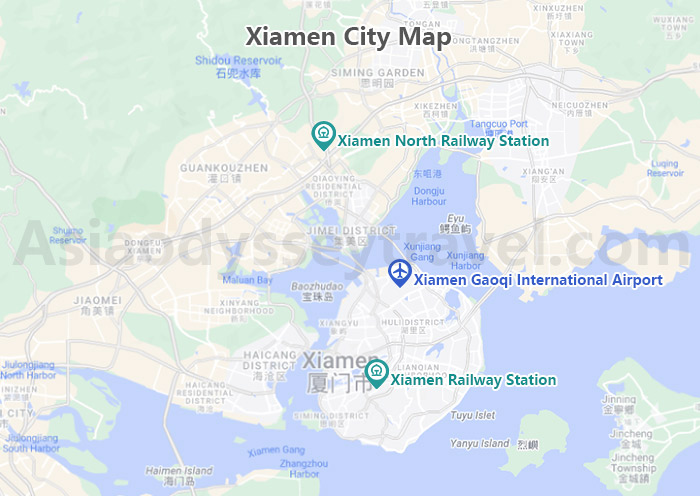
Xiamen Railway Station:
- Location: Situated in Siming District, Xiamen Railway Station serves conventional trains to various destinations within China.
- Transportation: Easily accessible by public transportation such as buses, taxis, and the Xiamen Metro Line 3. The station provides convenient access to the city center and surrounding areas.
Xiamen North Railway Station:
- Location: Located in Jimei District, Xiamen North Railway Station primarily serves high-speed trains (CRH) connecting Xiamen with major cities like Shanghai, Beijing, and Guangzhou.
- Transportation: Accessible by buses, taxis, and the Xiamen Metro Line 1. The station is an important transportation hub for high-speed rail travel in the region.
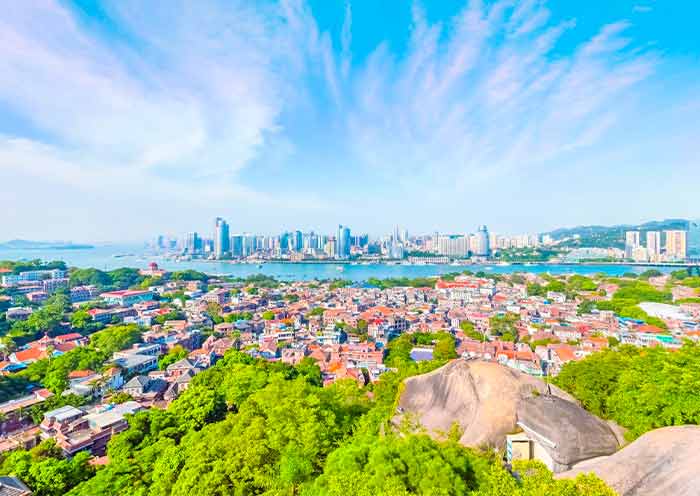

In Xiamen, these transportation facilities are crucial for facilitating travel for both domestic and international visitors, providing convenient access to the city and connecting Xiamen with other destinations in China through a well-developed transportation network.
Xiamen Travel Map: Travel around Xiamen with Map
Xiamen to Tulou (Nanjing) Map
Tulou, a cluster of earthen roundhouses in the Fujian province of China, is a UNESCO World Heritage Site known for its unique architecture and cultural significance. These structures, known for their defensive capabilities and unique architectural style, provide insight into traditional Chinese community living and craftsmanship.
-map-700.jpg)
Traveling from Xiamen to Tulou offers a journey through time, allowing visitors to explore the rich history and cultural heritage preserved within the walls of these ancient earthen buildings. It provides an opportunity to witness the harmonious coexistence of nature and human ingenuity, as well as to appreciate the communal lifestyle of the Hakka people.
- Distance: Approximately 135 kilometers (about 84 miles)
- By Overland: 2-3 hours
Xiamen to Quanzhou Map
Quanzhou boasts a wealth of historical sites, including temples, mosques, and ancient architecture that reflect its multicultural past as a hub for trade and cultural exchange. Visitors can explore attractions such as Kaiyuan Temple, Qingjing Mosque, and the Maritime Museum, offering insights into Quanzhou's diverse heritage.

Traveling from Xiamen to Quanzhou provides an opportunity to delve into the history and culture of this ancient city, known for its role in the maritime Silk Road and as a melting pot of different cultures. The journey allows travelers to witness the architectural splendor, religious diversity, and commercial legacy that have shaped Quanzhou into a unique destination in China.
- Distance: Approximately 85 kilometers (about 53 miles)
- By Overland: 1.5-2 hours
- By High-Speed Train: 20-50 minutes
Xiamen to Wuyishan Map
Wuyishan is renowned for its lush greenery, tea plantations, and the majestic Wuyi Mountain, a UNESCO World Heritage Site. Visitors can enjoy activities such as hiking, river cruises, and exploring ancient temples and cultural landmarks in the area.

Traveling from Xiamen to Wuyishan provides an escape from the urban environment into a realm of natural beauty and tranquility. The journey allows travelers to immerse themselves in the serene landscapes of Wuyishan, experience the local tea culture, and explore the rich biodiversity of the region. Visiting Wuyishan from Xiamen offers a rejuvenating experience for nature lovers, outdoor enthusiasts, and those seeking a peaceful retreat in the heart of nature.
- Distance: Approximately 500 kilometers (about 310 miles)
- By High-Speed Train: Xiamen to Wuyishan by high-speed train (around 2.5-3.5 hours)
- By Overland: 6-7 hours
Xiamen to Xiapu Map
Xiapu is famous for its expansive Xiapu Mudflat, bamboo pole-supported fishing nets, and picturesque coastal scenery that attract photographers and nature lovers. Visitors can witness traditional fishing practices, explore quaint fishing villages, and capture the serene beauty of the coastal landscapes.
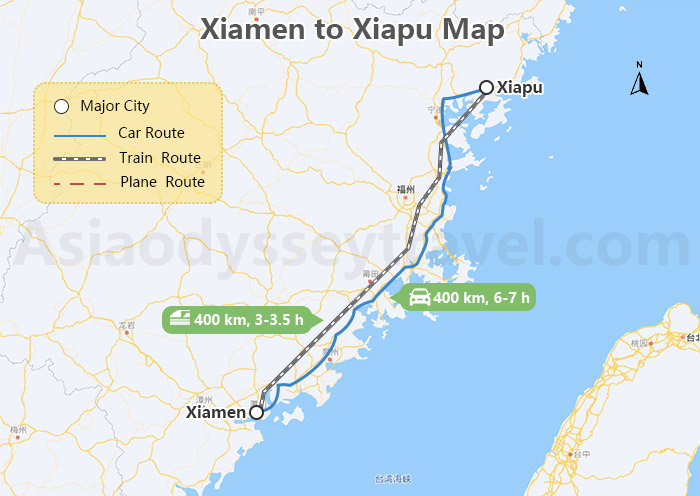
Traveling from Xiamen to Xiapu offers a unique glimpse into the coastal life of China and provides an opportunity to appreciate the natural beauty of the region. The journey allows travelers to immerse themselves in the rustic charm of fishing villages, witness the daily activities of local fishermen, and capture the enchanting landscapes that have made Xiapu a popular destination for photographers.
- Distance: Approximately 400 kilometers (about 248 miles)
- By High-Speed Train: 3-3.5 hours
- By Overland: Around 6-7 hours
Xiamen Tour Map: Plan a Tour to Xiamen With Map
Exploring Xiamen, Nanjing Tulou, and Wuyishan offers a journey through ancient history, unique architecture, and stunning natural landscapes. Here's a suggested itinerary for your trip:

Day 1: Arrival in Xiamen
- Arrive in Xiamen, a coastal city known for its charming seaside views and vibrant culture.
Day 2: Xiamen to Nanjing Tulou Round-Trip
- Travel to Nanjing Tulou Cluster, a UNESCO World Heritage Site showcasing unique Hakka roundhouses.
- Explore Tianluokeng Tulou Cluster, one of the most famous Tulou clusters in the area.
- Visit Taxia Village to experience traditional Hakka culture and cuisine.
Day 3: Xiamen Exploration, and High-Speed train to Wuyishan
- Visit Gulangyu Island, a UNESCO World Heritage Site with colonial architecture and lush gardens.
- Explore Zhongshan Road for shopping and sampling local snacks.
- Take a high-speed train to Wuyishan, a UNESCO World Heritage Site known for its dramatic cliffs, lush forests, and tea culture.


Day 4: Wuyishan Exploration and Departure
- Visit Wuyi Palace and learn about the history of Wuyishan.
- Explore the Nine-Bend River (Jiuqu Stream) by bamboo raft to admire the scenic beauty of the area.
- Hike or take a cable car to the summit of Mount Wuyi for panoramic views of the surrounding peaks.
- Visit Dahongpao Scenic Area to see the famous Dahongpao (Big Red Robe) tea bushes.
- Explore the Song Dynasty Imperial Tea Garden and learn about the tea-making process.
Day 5: Departure
- Depart from Wuyishan with memories of the unique tulou architecture, picturesque landscapes, and rich cultural heritage you've experienced.
